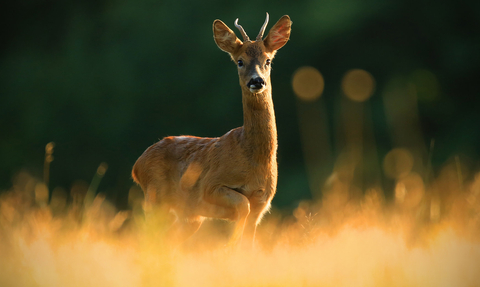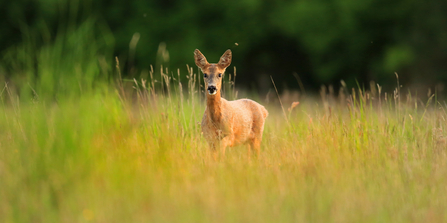
WildNet - Jon Hawkins - Surrey Hills Photography
London deer survey
Have you spotted deer in London?
London Wildlife Trust needs you to help us record sightings of wild deer.
We need you to tell us when and where you see deer in the capital, what species they are and how many you've seen. This helps us to understand their distribution and help determine likely population trends. This will help create future management strategies.
We already know a lot about the managed red and fallow deer herds in spaces like the Royal Parks. But we have far fewer records of the wild deer that roam in the capital's outer suburbs - mostly roe and muntjac.
We have put together this London deer survey, in collaboration with Greenspace Information for Greater London (GiGL). So if you see any deer in London - please let us know!
Deer are an important component of our natural heritage and seeing a wild deer in London is always a delight
We know deer sightings in London have been increasing, but we need to know more about their numbers and distribution to understand their possible impact on the capital's natural environment.
Wild deer numbers in Britain are now the highest they have been since post glacial times. Populations are increasing both in number and geographical locations, but exactly which species and where is not accurately known.
High densities of deer in woodlands can prevent natural regeneration of trees and shrubs, and adversely impact upon wildflowers and the shrub layer. Woodlands with high levels of deer will exhibit a very obvious ‘browse line’ at the height at which the deer can eat trees’ leaves.
This can have an impact upon a range of biodiversity, including breeding birds like blackcap and plants like wood anemone and bluebell.
As deer no longer have natural predators in Britain, deer management practices are likely to be required in order to help conserve woodlands; however we first need to know where the deer are and in what numbers.
Not enough is currently known about how many deer actually live in London or whether they are causing significant damage to woodland and other important habitats around the capital.

Urban fallow deer credit Jamie Hall
Take part in the London Deer Survey
We are seeking your support by taking part in our London Deer Survey.
We need you to tell us when and where you see deer in the capital, and ideally (but not strictly needed) what species they are and how many you've seen. This helps us to understand their distribution, determine likely population trends, and help shape future management strategies; your contribution to this work would be highly appreciated.
There are two options for participating:
1) If you are going for a walk, and you spot some wild deer or signs of wild deer (footprints, droppings, etc.), at any time of the year, you can let us know.
If you cannot identify the type of deer, you can still send us a record. If you don’t see any evidence of deer on a site, you can also report it. Every record, positive or negative, is very valuable!
Please don’t let us know about the deer in Richmond Park or Bushy Park; these are well-monitored herds, and we have plenty of information about them already.
Volunteer profile
- Anyone who has the means to visit a natural green space, preferably woodland.
- No previous survey experience is required.
- No need to go off-path.
Take part in the London deer survey, option 1
2) There are a number of sites that need to be surveyed more thoroughly for deer and we are looking for volunteers to help us. You don't need previous experience as we will provide everything you need in our survey pack. But you will need time available to visit some sites at dusk or dawn.
Volunteer profile
- Time available to visit at least one site, of a list of available sites, at dusk or dawn.
- No previous experience is needed, but training will be required.
- Capacity to walk off-path.
- Some travel expenses can be covered.

Roe deer
Photo credit: Jon Hawkins - Surrey Hills Photography
London Deer Strategy
London Wildlife Trust is working with a number of partners to develop a Deer Strategy for London. It will involve getting a deeper insight into the distribution and abundance of wild deer around Greater London, and their current and likely impacts on woodlands and other greenspaces.
We will be carrying out surveys for deer over 2022 and 2023, and the strategy will be published soon.
What deer are found here?
There are seven species of deer in Britain. Red and roe are native species. Fallow deer were introduced with the Normans in Medieaval times. Sika, Chinese water deer and muntjac were originally introduced from eastern Asia into enclosed deer parks within the last 150 years, and subsequently escaped. Reindeer, once native, became extinct in the 12th century, but reintroduced to the Cairngorms in Scotland in 1952.
All stags (males) grow and shed antlers annually except Chinese water deer which have tusks. Sometimes female deer (except Chinese water deer) can have small bumps on their heads.
Where to spot deer
Wild deer are most likely to be seen in London's outer fringes. There are regular sightings in the woods and parklands of the London boroughs of Barnet, Bromley, Croydon, Enfield, Harrow, Havering, Hillingdon, Redbridge and Waltham Forest. Some deer have even been reported at Sydenham Hill Wood, Tooting Bec Common and Finsbury Park.
Most prefer to live in woodland where there is significant cover, while muntjac can sometimes be seen in gardens. But many species use farm land, allotments, golf courses, London's parks and railway banks during the hours of darkness.
Chinese water deer, not yet recorded in London, are generally more selective and favour wetter habitats such as reedbeds.
When to spot deer
Deer are active through the day and night although the smaller species (roe, muntjac) are more likely to be nocturnal. But they will leave traces that reveal their presence, for example footprints in mud, droppings, fur caught in barbed wire, and the characteristic ‘browse line’ in woodlands or fields with old trees.
This project is part-funded by the Trees Call to Action Fund. The fund was developed by Defra in partnership with the Forestry Commission and is being delivered by The National Lottery Heritage Fund. TCAF is supported using public funds and delivered by The National Lottery Heritage Fund in partnership with Defra and the Forestry Commission.

